Introduction
An effective performance appraisal and management system is an integral part of the effectiveness of human resource management in the organization (Guest, 2011) and the resulting information can be used for various human resource activities (Bistakova, 2010). Employees’ performance appraisal creates the background for an agreement between supervisors and subordinates on how to play the roles in the future and how to provide feedback among them. Through the performance appraisal of employees, we can measure and monitor the achievement of expectations, achievement of objectives, compliance with standards, follow up of responsibilities, and performance of duties. Also, it allows identifying the training and development needs of individuals and plans for them (Vinogradova, E.Yu., Andreeva, S.L., Babkin, A.V., Galimova, A.I., 2017). This system helps employees gain a better understanding of their strengths and weaknesses and make better decisions about their professional issues (Daoanis, 2012).
In the present study, the subjects of dimensions’ meaningfulness and valuation indicators have been particularly considered, so that, the objectives and plans of the organization are well considered and followed up, as well as the interests of the employees.
Literature Review on Performance Appraisal
Motowidlo (2003) defined job performance as the total expected value added to the organization of the discrete behavioral episodes that an individual carries out over a standard period of time. Bernardine (2007) defined an individual’s performance record of outcomes produced as specified job functions or activities in a given period of time. According to another definition, the individual’s performance is the criterion of his success rate in doing a job, and usually comes from the individual’s output, or the assessment of the success rate of an individual’s behavior in comparison with organizational expectations (Mahdizadeh & Ilka, 2011). Therefore, personal and personality traits, or appraisal capabilities cannot be attributed to performance. On the other hand, performance can be regarded as a process, and the output of the individuals’ job cannot be considered as their performance.
The performance appraisal of employees consists of the formal review of the past performance, the determination of the points and related rewards, the determination of the objectives for future performance and planning for the development and advancement of employees (Sapra, 2012). Armstrong (2006) considered employees’ performance appraisal as a tool for reviewing and determining the employees’ work requirements in order to meet their career goals and new challenges. Armstrong and Baron (2005) also defined employees’ performance appraisal as an approach that involves supervisors in a hierarchical manner from top to bottom, and, according to this, the annual or periodic performance of subordinates can be ranked. Mirsepassi (2003) considered performance appraisal as a systematic measure of the work of individuals on how they perform their tasks in the assigned jobs and determine their potential for growth and improvement. Until the 1940s, regarding performance appraisal, the focus was on the behavior of employees. However, from around 1945, particularly based on the principles of Management by Objectives (MBO), the evident aspects of performance, that is, the outflow or the outcome of their work, were also considered (Prowse & Prowse, 2009). The most important terms and names used in this regard are: merit rating, behavioral assessment, employee evaluation, personnel review, staff appraisal, progress report, and performance appraisal.
As the previous statements expressed, in the performance appraisal of the employees, in addition to evaluating the performance, which is an ultimate and final endeavor, the efforts of individuals to achieve the desired performance are not excluded; what is called occupational ethics. Churchill, Ford, an Walker (1997) affirmed that behavior refers to what the workers actually do; that is, the tasks they expert effort on while working. In other words, behavior can be viewed as a reaction from the individual, which is directly or indirectly observed. Accordingly, occupational ethics refer to the formal and expected behaviors associated with the job, which are manifested deliberately and with inspiration in the framework of the psychological commitment of individuals (Wei, 2014) (Stiles, et al., 1997).
In assessing the occupational ethics, the process of work or the way in which the work is carried out is considered, and the order and stability of the procedure in the work process lead to the achievement of the same results that itself is a kind of quality definition (Mirsepassi, 2003). Therefore, performance appraisal is a periodic, formal and often written evaluation of employees’ behavior and occupational performance that is used to achieve different goals. The major causes of performance appraisal are the recognition of diligent employees and rewarding them, and creating incentives for improving their performance and other employees as well.
Purpose of The Performance Appraisal
It is possible to assess the role of an individual in realizing the goals of the organization by performance appraisal. People do not learn anything unless they receive feedback on their own actions. In order to improve the situation, feedback should be given and received on a regular basis, and it is necessary to point out both successes and failures in this regard (Toppo & Prusty, 2012).
Longenecker & Nykodym (1996) stated that a performance appraisal system; a) provides a specific performance feedback to improve the performance of the employees, b) determines the training requirements of the employees, C) provides and facilitates the development of the employees, d) establishes a close relationship between privileges and performance, and e) increases the motivation and productivity of the employees. Also, Roberts and Pavlak (1996) argued that performance appraisal can be used for multiple administrative and developmental purposes, including; a) evaluating individuals’ performance according to organizational needs, b) anticipating feedback to employees to modify or reinforce their behaviors, c) rewarding and promoting the occupation of individuals.
In short, the main objectives of employees’ performance appraisal can be summarized as follows (Toppo & Prusty, 2012):
- Providing the necessary information to create a reward system in order to provide appreciation, promotion, and so on; and manager salary affairs.
- Providing feedback and appropriate guidance from reporting units to employees.
- Increasing the effectiveness of employees by helping them overcome their weaknesses and improving their performance through appropriate training and development programs.
- Helping employees identify motivational and educational issues.
- Providing accurate, authoritative and reliable information about employees.
The main focus in the former performance appraisal systems have been on problem solving, while today, it is seen as an opportunity for development and support of employees (Figazzolo, 2013). DeNisi and Pritchard (2006) emphasized that it is necessary to avoid the excessive focus on the psychological issues in criteria of performance appraisal, and instead, the focus should be on issues that motivate employees to improve their performance. The response of employees to evaluation is affected by factors such as fairness, veracity, accuracy and satisfaction, and their perception of these factors can motivate them to improve their performance (Roberson & Stewart, 2006). This means that employees’ performance appraisal can be considered as a tool for providing feedback in order to improve performance (Selvarajan & Cloninger, 2009). Therefore, one of the most important considerations in designing and deploying an employees’ performance appraisal system is to determine the dimensions of the evaluation in order to increase the positive response of the employees and, consequently, increase their incentive to improve their performance. The previous studies indicate that the evaluation method and its related characteristics, including the evaluation resources and its related objectives, have a significant role in the positive reaction of the employees and, consequently, increase their motivation for improving their performance (DeNisi & Pritchard, 2006).
Methodology
The following primary process (Figure 1) has been used to carry out the macro plan of performance appraisal process (Schneier, et al., 1986),
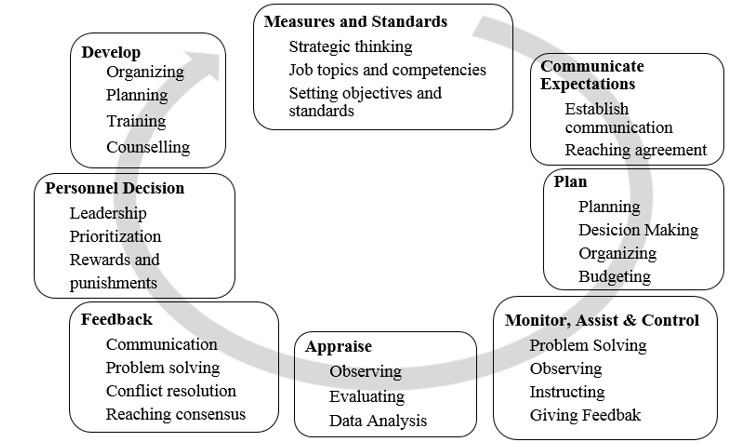
Fig.1:Eight stages of performance appraisal process
In practice, the following executive process (Figure 2) is used to carry out the project: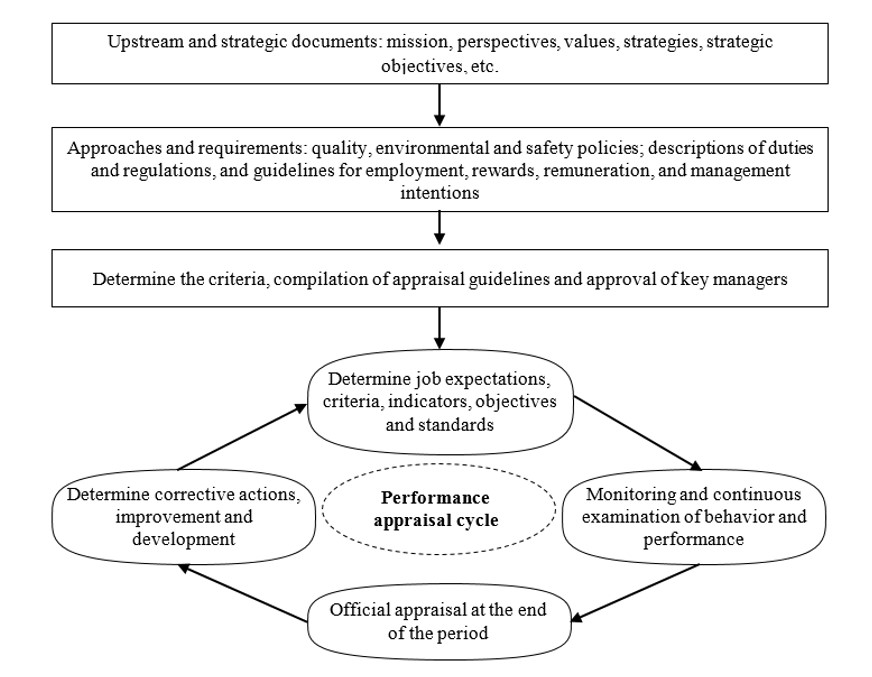
Fig. 2: The performed performance appraisal process
This research can be considered practical in terms of type and purpose, and descriptive in terms of nature and method. The entire target community included 800 personnel, which are divided into three main categories of directors and supervisors, experts and officials, and employees and operators. The entire statistical population was subject to data collection, given that in the elementary stage, most people, including employees and their direct supervisors were not familiar with the design, the coincidence of data collection by the end of the year, the high number of appraisal questions, and the consideration of employees’ appraisal at three levels. Therefore, no sample was identified for collecting initial data. One of the other goals in selecting the entire population to complete the questionnaires was to assess the behavior of appraisers and evaluators in carrying out the work, which was especially important in the field of how to complete open-ended questions.
Data collection and analysis tools
The most important tools for collecting data and information to finalize the questionnaire and complete it by appraisers and evaluators are the following:
- Library research
- Benchmarking governmental and non-governmental organizations
- Field survey (executive document)
- Review strategies, plans, policies and guidelines
- Survey questionnaire
- Assessment questionnaire
- Expert meetings (key units’ representatives)
SPSS software was used to summarize and analyze the data at descriptive and inferential levels.
Steps to conduct the research
Since the purpose of this project is to design and establish a suitable model to appraise the performance of employees and operators, experts and officials, and directors and supervisors of Golgohar Mining and Industrial Company, the research method can be considered as a research and development method that involves the following 8 steps:
Stage one – organizing and explaining the executive process: At the beginning of the project, its objectives are discussed with relevant authorities and stakeholders. Also, the significant factors and prospects of the exploitation of the results of the project, as well as the characteristics of the desirable appraisal system and its achievements for the company and its employees are explained.
Stage two – establishing the executive committee of employees’ appraisal: At this stage, a work group is organized under the name of the executive committee of employees’ appraisal consisting of representatives of key and relevant units. The most important role of this committee can be elaborated in the criteria of appraisal and approval of the relevant guidelines.
Stage three – determining the dimensions of employees’ appraisal and the overall evaluation method: At this stage, firstly, the research team and its colleagues determine and suggest the dimensions of the evaluation and the key points using previous records of employees’ appraisal in the company, goals, programs, and basically upstream documentation, studying the experiences of various governmental and non-governmental organizations, and in particular, holding a brainstorming session with the members of the appraisal committee. Then, during the meeting at the committee, the evaluation dimensions and the overall evaluation method are reviewed and approved.
Stage four – compilation of evaluation items: After determining the dimensions of the evaluation, an elaboration of the appraisal behavior items for each evaluation dimension for different job categories has been conducted by the committee based on the suggestions of the research team. Moreover, the individual characteristics considered under the dimensions and behavioral items and, of course, this section of the items became more prominent. In terms of functional or specific items, three factors of quality, quantity and reporting are noted, and the elaboration of items and related criteria are postponed to the agreement between assessors and assessees.
Stage five – preparing tools for measuring and data collection: To perform appraisal and collect data, a questionnaire based on open and closed questions and mechanisms of self-assessment and supervisor appraisal is used.
Stage six – data collection: At this stage, information was gathered to finalize the appraisal method by using the necessary tools including questionnaires and field surveys of the responses of individuals during the completion of the questionnaire. For behavioral items, three options are used with the level of “less than expectation” with quantitative interval of [1, 3], “expectation realization” with quantitative interval of [3-5], and “beyond expectation” with quantitative interval of [5-7]. For functional items, the unit of measurement for the specific index, the expected quantitative objective at the end of the appraisal period, the standard as the minimum of the index, the performance as the actual value of the index and the related unit of measurement based on the quantitative and visual evidences, and finally the score as a quantitative or percentage of expectations realization related to the index, are considered.
Stage seven – analysis of the results: As stated above, to measure the status of items at different levels, the quantitative interval used a continuous scale of 1 to 7. The considered weights for assessors and assessees are and , respectively. Also, in this stage, descriptive and inferential statistical methods are used to understand the differences, determine the validity and reliability, and also to extract the competency model of the different levels of the appraised employees.
Stage eight –pilot implementation: At the final stage, after finalizing the dimensions and items, the appraisal is carried out experimentally throughout the company. By analyzing the results of this stage, changes are made in the questionnaire, the way of completion and related appraisal items, the appraisal guidelines compiled and in the model of competency extracted for the appraised job categories.
Appraised Dimensions
Behavioral and functional dimensions of appraisal are considered for employees of different job categories, which are allocated in Table 1:
Table 1: Behavioral and functional appraisal dimensions for employees of different job categories
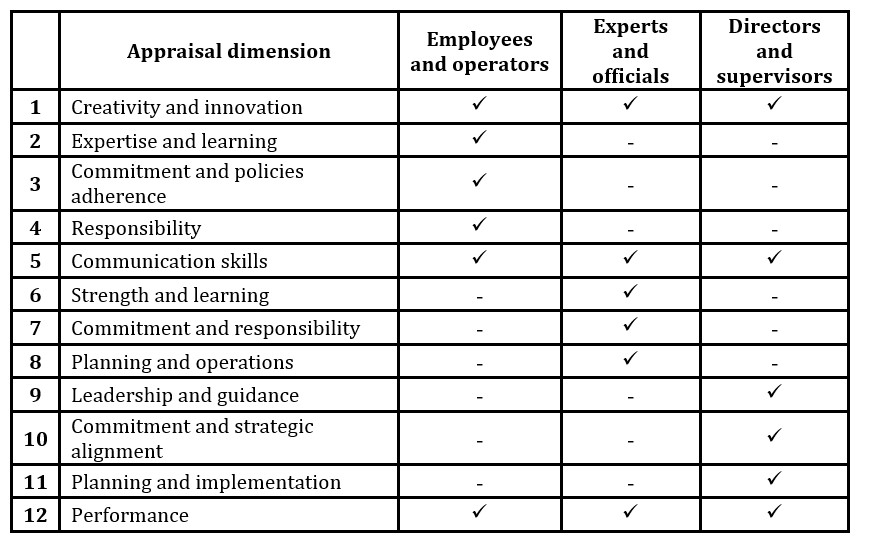
The agreed definitions for the mentioned dimensions are as follows:
- Creativity and Innovation: it can be said that creativity refers to the new factors and issues, and innovation addresses the process of using knowledge or related information to create or introduce new and useful things that are valuable and strengthens the position of the organization in the business. Generally, creativity and innovation can be defined as presenting new subjects through visualization, subjectivity, creation, improvisation, interpretation, and art, and using them in order to create values and ensure the competitive interests of the organization.
- Expertise and Learning: expertise is a kind of a special ability that enables individuals to have a clear position and job at the community and organization level. Learning is a relatively stable change in behavior and cognition, or, effects that result from an individual’s interaction with the environment and cannot be attributed to temporary conditions of the body, such as those resulting from illness, fatigue, or drug use(Seyf, 2007). Therefore, in the dimension of expertise and learning, the individual’s knowledge and firmness in a particular career and its continuity, despite various changes in the goals, technology and business relationships are considered. Education and experience in this field are very important (Vetrenko, P.P., Chernysheva, E.A., Levitina, I.Y., Voronkova, O.V., Mikheeva, D.G., 2017).
- Commitment and policies adherence: Porter (1974) defines commitment as adopting the organization’s values, and engagement in its affairs. He considered its measuring criteria as: motivation, willingness to continue working, and adopting organization’s values. Employees’ commitment has been considered as one of the five essential pillars of the total quality management. The commitment of individuals to the organization and its values affects the type of individuals’ relationship with the organization, the way in which laws and regulations are followed, the amount of effort, and the willingness to remain in the organization. Therefore, the dimension of “Commitment and policies adherence” refers to the acceptance degree of the organization and its values, and the amount of committed endeavors.
- Responsibility: one of the definitions of responsibility in the Oxford Dictionary is: A thing which one is required to do as part of a job, role, or legal obligation. Therefore, the person in charge of the work agrees to carry out the activities and work or to supervise the work of others. The dimension of “Responsibility” refers to the individual’s tendency to follow such a thing.
- Communication skills: refers to behaviors through which an individual can communicate in a way that is consistent with the positive responses, and the avoidance of negative responses. This is almost noteworthy for all job categories, because in any case, all people are connected with individuals inside or outside the organization either through conversation, communication or body language. Using communication skills, employees can transfer their views and ideas to others and benefit from their views and thoughts as well.
- Strength and learning: strength is a “the ability to provide consistent, near-perfect performance in a given activity”(Buckingham & Clifton, 2001). Strength can be anything that is hidden or evident that the timely use of it will meet the needs, solve problems or prevent them. Thus, in the dimension of “strength and learning”, issues will be addressed that include the intrinsic talent of individuals as well as their growth and development in order to be more professional and to meet individual and organizational goals.
- Commitment and Responsibility: in addition to the previous explanation, it is important to note that commitment and responsibility are aligned with each other in some cases.
- Planning and Implementation: Planning is a directed and systematic effort to determine future activities with respect to available resources and their compatibility with the organization’s unlimited needs. Planning involves: determining the objective and policy, turning the objective into a program, operating, and predicting how to implement it (Rezaian, 2006). In each program, the way to deal with the various factors is determined within the framework of the system and defined scopes (Pirogova, O.; Plotnikov, V., 2019). Therefore, each program can be considered as a set or sequence of meaningful behaviors at micro and macro levels. The program can be defined as the “how” which comes as an answer to the “what”. In the “Planning and implementation” dimension, attention is paid to issues related to how the operation is planned and implemented.
- Leadership and guidance: A leader is someone who is committed to making a change and encourages others to do so. He challenges the current situation of the organization and creates new conditions for doing things better(Katzenbach, 1996). In today’s organizations, leaders have a responsibility to explain goals, strategies and behavioral patterns. The dimension of “Leadership and guidance” addresses that, assesses should be able to identify subordinates’ responsibilities, inspire and motivate individuals to follow up their duties, and guide and support them if needed (Gintciak, A.M.; Bolsunovskaya, M.V.; Redko, S.G., 2019).
- Commitment and strategic alignment: Ensure the alignment of commitment and behaviors related to the organization’s core objectives and strategies (Mednikov, M.D., Sokolitsyn, A.S., Ivanov, M.V., Sokolitsyna, N.A., 2017).
- Planning and implementation: refers to playing a role in the planning and implementation of affairs.
- Performance: In fact, this is the only dimension related to the appraisal of the functional aspect and refers to the outputs or objective results from the work behaviors. The amount of production, the amount of service provided, the amount of waste and the like, whose data is usually recorded in the documentation of the organization, can be indicative of an individual’s performance. To measure individuals’ performance in accordance with organizational goals and within the superior’s expectations during the appraisal period, the activities, projects, or plans are considered, and based on that, the quantitative and qualitative status of the outputs and the results of the implementation of these activities are examined, and the scores are calculated. Performance indicators are usually determined in a quantitative measure and in accordance with the organizational status of each employee. In order to better determine the items, one can consider the factors of the success of an individual in the job according to the job description and the assigned duties, and then point out to the values that are created quantitatively and qualitatively by the individual according to these factors. For each functional item, the measurement unit, the target and the standard or the least expectation should be determined, which can be done by the assessors and the assesses participation, e.g. the performance of an accountant can be assessed as the result of dividing “the number of computational errors by the number of accounting operations” as a functional indicator with the measurement unit of percent. Also, in the case of assessing the head of a unit for transferring ore from mine to the processing plant, the indicator can be considered as “the total cost of operation by displaced tonne-kilometre” with the measurement unit of riyal (or any other currencies, e.g. dollar).
The items related to the dimensions of performance appraisal
Some of the introduced appraisal dimensions are common for all job categories and some are specific. However, the conditions and the manner of playing the role by the employed individuals in the mentioned job categories have been taken into consideration for determining the related items. Five items have been developed for the compilation of these items. First, the suggested items related to the appraisal dimensions are presented by the research team. Subsequently, the issue was discussed at the executive committee of employees’ appraisal and members’ views were received. In the next step, the necessary amendments were made by the research team and sent to the members of the committee and to the heads and directors of different departments of the company to receive final points of view. By summarizing the received views, the research team completed the latest reform and applied it in the initial form of appraisal. Table 2 introduces the functional and behavioral items of the experts and officials’ appraisal according to the latest changes.
Table 2: final behavioral and functional items of the experts and officials’ appraisal
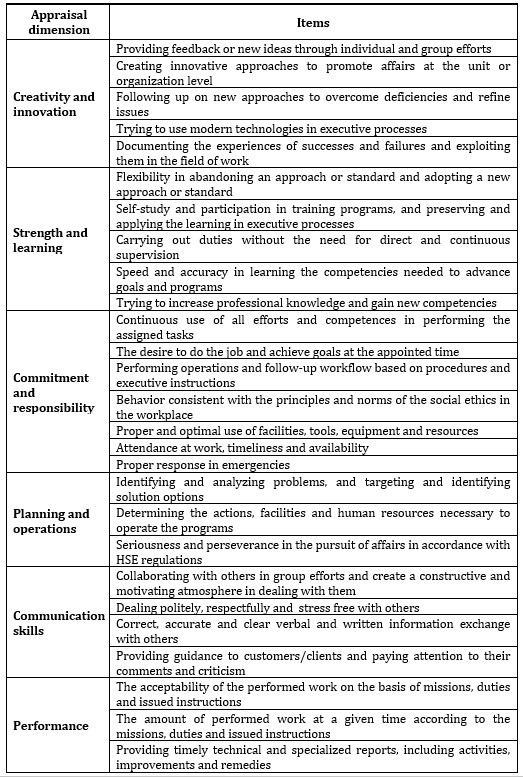
Results and Discussion
A total of 153 appraisal forms have been completed in nine units of the company, which includes Department of development projects, Department of safety and health, Department of mining, Department of energy, Transactions committee, Department of production technology, Department of security, Department of IT, and Department of systems and human resource development. The total number of completed forms in the three categories of “Employees and operators”, “Experts and officials”, and “Directors and supervisors” are 37, 86, and 30, respectively. Due to conducting the same type of survey as well as the appropriate number of collected questionnaires, only the data analysis from the appraisal of the “experts and officials” category is followed.
Analysis of experts and officials’ appraisal
As indicated before, a total of 86 forms are completed for appraising experts and officials. The behavioral criteria of this form consisted of 24 items. The status of these items is shown on the basis of self-appraisal and supervisor appraisal in Table 3.
Table 3: statistical status of items based on completed appraisal form

Table 4 shows the normality test of the completed items by assessors and assessees based on the Kolmogorov-Smirnov test. As can be seen, the null hypothesis is not accepted at the error level of 0.01, indicating that every completed item is normally-distributed.
Table 4: the results of Kolmogorov-Smirnov test
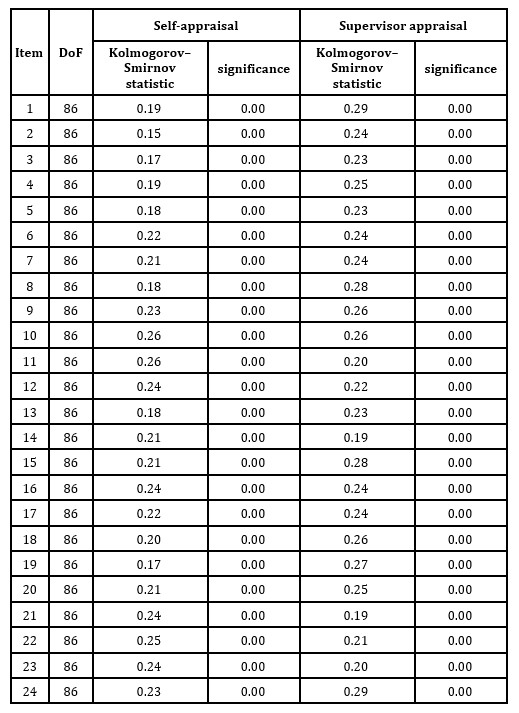
The skewness is used to determine the mean and mode arrangement in the frequency distribution of self-appraisal and supervisor appraisal data, and a histogram is plotted to represent it. Likewise, each item is appraised, however only the first item (based on Table 2) is analyzed. According to the skew statistics for the data obtained from self-appraisal, as shown in Table 5, the mean is higher than the mode, and the distribution is skewed to the right (Figure 3-a). Also, for supervisor appraisal data, the mean is less than the mode, and the distribution is skewed to the left (Figure 3-b).
Table 5: data analysis related to the first item: Providing feedback or new ideas through individual and group efforts

According to Table 6, the correlation between data is not statistically significant at the error level of 0.1. Also, the difference in the mean of data at the error level of 0.1 is not statistically significant (Table 7).
Table 6: Correlation between data of self-appraisal and supervisor appraisal
Table 7: Difference in data of self-appraisal and supervisor appraisal

Friedman test is used to investigate the significance of the mean difference between the self-appraisal and the supervisor appraisal. In fact, the aforementioned test ranks the mean of appraising each item. According to Table 8, as well as the related statistics, the null hypothesis is not accepted, indicating that the mean of self-appraisal and supervisor appraisal for the appraisal items are equal.
Table 8: The result of Friedman test for self-appraisal and supervisor appraisal

To assess the statistical significance of the scoring difference through self-appraisal and supervisor appraisal, the Spearman rank test is used based on the data obtained from the Friedman test. Therefore, given the obtained value in Table 9, it is impossible to reject the null hypothesis, indicating that correlation between the two types of appraisal.
Table 9: The Spearman’s for self-appraisal and supervisor appraisal

Analysis of variance is used to evaluate the difference between the appraisal items among different units. In other words, the null hypothesis is tested for all the units, indicating that the mean of the items is the same. Table 10 summarizes the results.
Table 10: Results of variance analysis 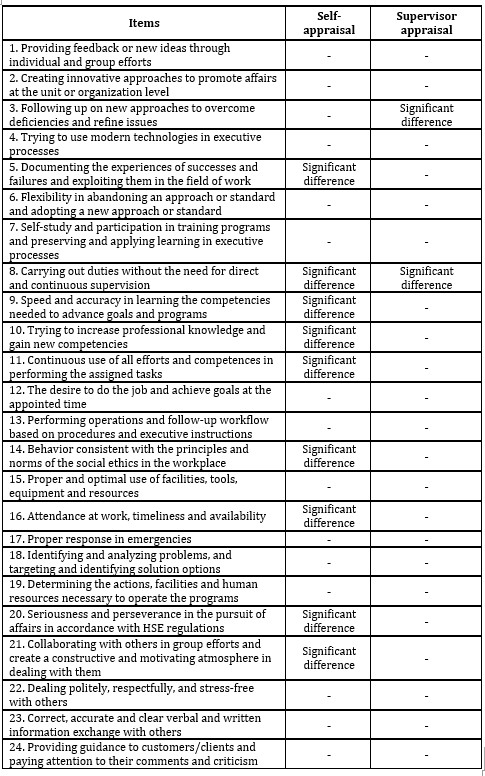
Factor Analysis of experts and officials’ behavioral appraisal
Factor analysis is a general name for some multivariate methods, which aims at summarizing the data. This method examines the internal correlation of a large number of variables, all of which are considered as dependent variables. The factor analysis is used to answer the question whether the assessment can be described based on the smaller factors or dimensions, and what each attribute or feature of each dimension is. In order to perform factor analysis, the correlation matrix between factors is considered first. To evaluate the correlation matrix and to examine the significance of this, Bartlett’s sphericity test can be used as Eq. (1),

Where is Chi-square, represents the sample size, is the number of variables, and is the absolute value of the correlation matrix determinant. This characteristic, which has a chi-square distribution of 0.5 p (p-1) degrees of freedom, evaluates the amount of information in by evaluating the relationship between observations and the number of variables, and tests the probability of error to reject the null hypothesis (no difference from the identity matrix). The identity matrix has diagonal elements of 1 and non-diagonal elements of zero. When the hypothesis that the correlation matrix is an identity matrix cannot be rejected, the matrix should not be factor analyzed (Pedhazur & Schmelkin, 1991).
The size of the KMO (Kaiser-Meyer-Olkin), which is the sample adequacy indicator, compares the observed correlation values with the partial correlation values (Eq. (2)).

Where is the simple correlation coefficient between variables , and is a partial correlation coefficient between them. Measures larger than 0.9 are excellent, in the 0.8 range are appropriate, in the 0.7 range are better than moderate, in the 0.6 range are moderate, in the 0.5 range are undesirable and below 0.5 are unacceptable. The size of (Measure of Sampling Adequacy) for each individual variable can also be calculated based on the Eq. (3)

In this paper, as already mentioned, the appraisal is carried out in two ways by the self-appraisal and supervisor appraisal. Here, only the analysis of the supervisor assessment is referred to. By entering the experts’ appraisal data into the SPSS software, the data adequacy index is first computed, and then the Bartlett’s sphericity test is performed. The results are illustrated according to Table 11.
Table 11: KMO and results of Bartlett’s sphericity test

As can be seen, the data adequacy index is presented at a good level. Bartlett’s sphericity test also rejects the null hypothesis, meaning that the identity matrix and the correlation coefficients matrix are the same. At each significant level, the hypothesis of the variables independence is rejected, indicating that at least a significant correlation is found between these variables. Given that the KMO index is high, there is no need for an anti-image matrix. However, extracting the matrix indicated that it is not necessary to exclude any of the variables or items.
Table 12 shows the explained variance of different items using the principal component analysis method. As can be seen, five major components have been extracted, accounting for over 70% of the variation. Then, by varimax rotation, based on five extracted factors and after nineteen repetitions and analyzing the result, it can be concluded that the individuals consider the following five components in appraising the behavior of experts and officials:
- Proper treatment
- Proper response to the current situation
- Follow up for proper use of experiences and learning
- Creativity and innovation
- Learning new ways of doing the job
Also, items 11, 13, 15, and 16 bridge the above mentioned components, e. g. item number 11, “Continuous use of all efforts and competences in performing the assigned tasks “, implies that the experts should be able to accomplish their tasks by utilizing their experiences through healthy and constructive communication.
Table 12: Table of variance explained
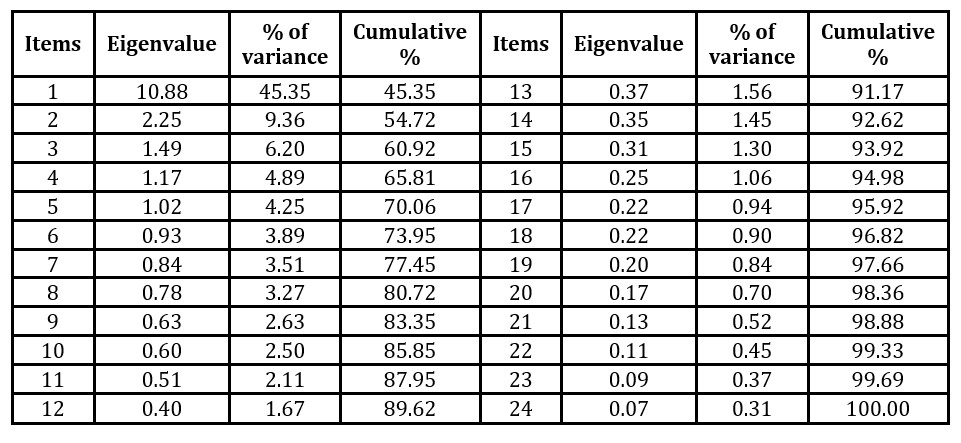
Reliability Analysis of experts and officials’ behavioral appraisal
Reliability analysis is generally determined based on the appraisal dimensions and the extracted components. Here, only the reliability based on the extracted components is referred to in Table 13. All the extracted components have high reliability. However, as the item “Follow up on new approaches to overcome deficiencies and refine issues” from component “creativity and innovation” was deleted, it would increase the reliability by 0.905. Possibly the item has been ambiguous for assessors and they have not been able to provide a satisfactory answer for it.
Table 13: Reliability analysis based on extracted components
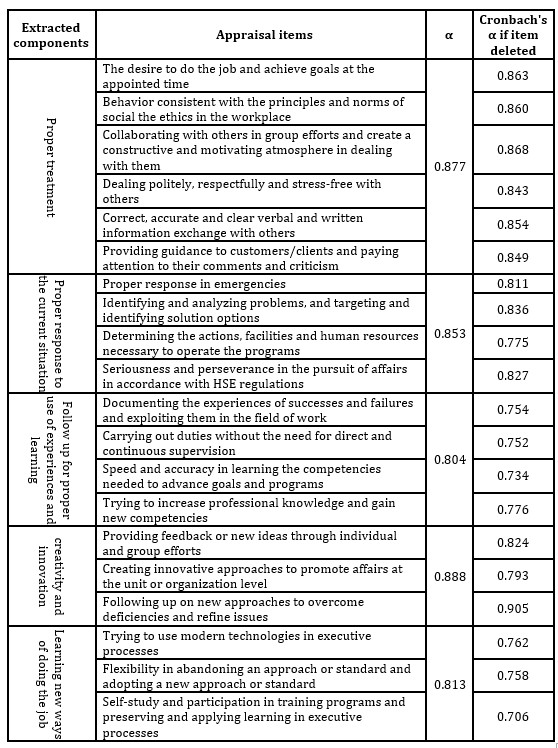
According to the results of factor analysis and reliability analysis, the dimensions and appraisal items of experts and officials were modified as presented in Table 14.
Table 14 : Modified appraisal dimensions and items
Conclusion and Suggestion
In this research project, the dimensions and appraisal items of the behavior and performance of the employees were determined in three categories of “Directors and supervisors”, “Experts and officials”, and “Employees and operators” based on the principles and methods in the literature of the employees’ performance appraisal system and the upstream documentation of the company. Then, using various analyses such as factor analysis, reliability analysis, and evaluating the degree of coordination and convergence of assessor, the related questionnaires were standardized.
The appraisal seeks to consider the individuals role-playing as well as their performance. Performance indicators create the conditions to avoid compliance with the affairs in a dabbled manner, and challenge individuals to act in accordance with operational plans and their responsibilities to meet the individual and organizational interests.
In order to strengthen the process and the results of the appraisal, most of the existing mechanisms in the literature are considered in the appraisal forms, and a complete cycle is designed including documentation and guidelines for measuring and appraising behavior and performance, giving new responsibilities, rewards and promotion, designing improvement programs, and further implementing and appraising the effectiveness of the mentioned actions.
However, special attention needed to be given to the dynamics and changes related to the strategic documents, executive processes and related requirements, the missions and duties of employees, and the mutual expectations of employees and the organization from each other; accordingly, it is suggested that along with the annual appraisal, reporting and implementing the results based on a defined process, instructions and statistical analyses should be performed to ensure the reliability of the criteria and the appraisal items. Also, some of the information necessary to improve the system and executive processes of employees’ performance appraisal can be extracted through a survey of assessors and assesses within a framework of the questions contained in the appraisal form. In this regard, it is essential that the employees and their direct supervisors take the necessary training on the principles and concepts of performance appraisal as well as the way in which the executive process is carried out.
Acknowledgment
This research work was supported by the Academic Excellence Project 5-100 proposed by Peter the Great St. Petersburg Polytechnic University.
(adsbygoogle = window.adsbygoogle || []).push({});
References
- Armstrong, M. & Baron, A., 2005. Managing Performance: Performance Management in Action. London: CIPD.
- Armstrong, S., 2006. Blending formal and informal approaches to management learning. New York: McGraw-Hill.
- Bernardin, H. J., 2007. Human Resource Management. New York: McGraw-Hill.
- Bernardin, J., 2003. Human Resource Management: An Experiential Approach, 3rd Edition. New York: McGraw-Hill.
- Bistakova, J., 2010. Employees’ Appraisal as an Indictor of the Quality of Human Resources Management in Organization in Slovakia. The International Review of Applied Economics, 7(2), pp. 79-90.
- Buckingham, M. & Clifton, D. O., 2001. Now, Discover Your Strengths. New York: The Free Press.
- Churchill, G. A., Ford, N. M. & Walker, O. C., 1997. Sales force management. Toronto: Irwin.
- Daoanis, L. E., 2012. Performance Appraisal System: It’s Implication To Employee Performance. International Journal of Economics and Management Sciences, 2(3), pp. 55-62.
- DeNisi, A. & Pritchard, R., 2006. Performance Appraisal, Performance Management and Improving Individual Performance: A Motivational Framework. Management and Organization Review, 2(2), pp. 253-277.
- Figazzolo, L., 2013. The Use and Misue of Teacher Appraisal an Overview of Cases in the Developed World. Brussels: Education International.
- Gintciak, A.M.; Bolsunovskaya, M.V.; Redko, S.G., 2019. Comparative analysis of approaches to the employees’ distribution among the organization’s projects. s.l., Proceedings of the 33rd International Business Information Management Association Conference, p. 4690-4694.
- Guest, D. E., 2011. Human resource management and performance: a review and research agenda. The International Journal of Human Resource Management , 8(3), pp. 263-276.
- Ivancevich, J. M., 2007. Human Resource Management. New York: McGraw-Hill Irwin.
- Katzenbach, J. R., 1996. Real change leaders. New Jersey: McKinsey Quarterly.
- Longenecker, C. & Nykodym, N., 1996. Public Sector Performance Appraisal Effectiveness: A Case Study. Public Personnel Management, 25(2), pp. 151-164.
- Mahdizadeh, A. & Ilka, H., 2011. Studying the Relationship between Quality of work life and Employee Performance of the Islamic Azad University of Firoozkooh Branch Based on the Walton Model. Journal of Industrial Strategic Management, 7(20), pp. 1-8.
- Marchington, M. & Wilkinson, A., 2002. Human Resource Management at Work. s.l.:CIPD – Kogan Page.
- Mednikov, M.D., Sokolitsyn, A.S., Ivanov, M.V., Sokolitsyna, N.A., 2017. Forming optimal enterprise development strategies. s.l., Proceedings of the 30th International Business Information Management Association Conference, p. 1053-1063.
- Mirsepassi, N., 2003. Human Resources Strategic Management & Labour Relations. Tehran: Mir Book Publishing House.
- Motowidlo, S. J., 2003. Job Performance, Handbook of Psychology. In: s.l.:John Wiley & Sons, Inc, pp. 39-53.
- Pedhazur, E. J. & Schmelkin, L. P., 1991. Measurement, Design, and Analysis: An Integrated Approach. New Jersey: Lawrence Erlbaum Associates.
- Pirogova, O.; Plotnikov, V., 2019. The model of commercial enterprise value managing (strategic level). s.l., Proceedings of the 33rd International Business Information Management Association Conference, p. 928-935.
- Porter, M., 1974. Consumer Behavior, Retailer Power and Market Performance in Consumer Goods Industries. The Review of Economics and Statistics, 56(4), pp. 419-436.
- Prowse, P. & Prowse, J., 2009. The dilemma of performance appraisal. Measuring Business Excellence, 13(4), pp. 69-77.
- Rezaian, A., 2006. Fundamentals of Organization and Management. Tehran: SAMT.
- Roberson, Q. & Stewart, M., 2006. Understanding the motivational effects of procedural and informational justice in feedback processes. British Journal of Psychology, 97(3), pp. 281-298.
- Roberts, G. E. & Pavlak, T., 1996. Municipal Government Personnel Professionals and Performance Appraisal: Is There a Consensus on the Characteristics of an Effective Appraisal System?. Personnel Administration , 25(3), pp. 379-408.
- Sapra, N., 2012. Current Trends in Performance Appraisal. International Journal of Research in IT & Management, 2(2), pp. 1203-1212.
- Schneier, C., Beatty, R. & Baird, L., 1986. How to construct a successful performance appraisal system. Training & Development Journal, 40(4), pp. 38-42.
- Selvarajan, R. & Cloninger, P., 2009. The influence of job performance outcomes on ethical assessments. Personnel Review, 38(4), pp. 398-412.
- Seyf, A., 2007. Modern educational psychology. Tehran: Duran publication.
- Stiles, P., Gratton, L. & Truss, C., 1997. Performance management and the psychological contract. Human Resource Management Journal, 7(1), pp. 57-66.
- Toppo, L. & Prusty, T., 2012. From Performance Appraisal to Performance Management. IOSR Journal of Business and Management, 3(5), pp. 1-6.
- Vetrenko, P.P., Chernysheva, E.A., Levitina, I.Y., Voronkova, O.V., Mikheeva, D.G., 2017. Encouraging Employees to Increase the Labor Intellectualization Level as a Factor of Evolution of the Intellectual Capital. European Research Studies Journal, 20(4), pp. 568-577.
- Vinogradova, E.Yu., Andreeva, S.L., Babkin, A.V., Galimova, A.I., 2017. Corporate information system – Element of efficient human resources management of the industrial-economic complex. s.l., Proceedings of 2017 IEEE 6th Forum Strategic Partnership of Universities and Enterprises of Hi-Tech Branches (Science. Education. Innovations), SPUE 2017, p. 63-66.
- Wei, Y., 2014. The Benefits of Organizational Citizenship Behavior for Job Performance and the Moderating Role of Human Capital. International Journal of Business and Management, 9(7), pp. 87-99.






















